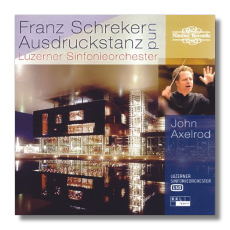
The Internet's Premier Classical Music Source
Related Links
- Latest Reviews
- More Reviews
-
By Composer
-
Collections
DVD & Blu-ray
Books
Concert Reviews
Articles/Interviews
Software
Audio
Search Amazon
Recommended Links
Site News
 CD Review
CD Review
Franz Schreker

Ausdruckstanz Ballet Music
- The Birthday of the Infanta
- Valse Lente
- The Wind
- Festive Waltz & Waltz Intermezzo
- Ein Tanzspiel
Lucerne Symphony Orchestra/John Axelrod
Nimbus NI5753 71m DDD
When in 1907, the sisters Grete and Elsa Wiesenthal left the ballet corps of the Vienna Court Opera to dedicate their efforts to the new fashion of interpretative dance known as 'Ausdruckstanz', a bright and innovative chapter was just about to open in both the latest trends in Austrian modern art and Franz Schreker's career.
Up till then Schreker's name would hardly raise an eyebrow, but when in 1908 Gustav Klimt invited the Wiesenthals to perform at the 'Kunstschau', the principal work for performance was a pantomime based on Oscar Wilde's play, 'The Birthday of the Infanta' with music by the then unknown composer. The première on 27th June 1908 was an instant success and between 1908 and 1910, Schreker wrote six dance works that were either commissioned or inspired by the Wiesenthal sisters. This CD incorporates the five pieces that have survived with 'The Infanta' taking up almost half the playing time.
In 1923, Schreker published an orchestral suite, but the version recorded here is the original conception which has a more transparent and smaller orchestration. Several crucial scenes have also been restored. The work is outstanding not only for its inventive developments but also for an expressive intensity that anticipates most of Schreker's future work, particularly so his 1918 opera 'Die Gezeichneten'.
The 'Festwalzer' also of 1908, is unusual in that its celebratory aim (the 60th anniversary of Emperor Franz Josef I's reign) is subverted by a substantial tone of parody. Haydn's national anthem of 1797 forms the core of this particular piece. 'The Wind' of 1909 is a sophisticated dramatisation (for five instruments) of the mysterious aspects of this natural element. 'Valse Lente' was written for Elsa in 1910 after she and Grete parted ways. It is an enigmatic but beguiling work that has all the traits of a Viennese waltz.
The final composition on this disc is the 1910 'Tanzspiel' which is a perfect example of the mixture of baroque and Classical forms with that of Viennese modernism. Axeland's uncanny sense of detail is manifested in performances of worth, clarity and flexibility by the Lucerne Symphony Orchestra.
Copyright © 2006, Gerald Fenech




















